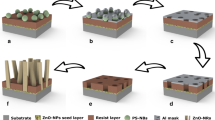Abstract
We present a novel method for fabricating two-dimensional arrays of zinc oxide (ZnO) nanorod patterns. Vertically aligned ZnO nanostructure patterns were synthesized by hydrothermal growth on a two-dimensional seed layer pattern formed by atomic layer deposition. Various characteristics of ZnO seed films were experimentally studied in order to optimize the fabrication of ZnO rod structures in terms of their uniformity and vertical alignment on the two-dimensional-patterned surfaces. Using these ZnO structures as hierarchical electrodes, we demonstrate that localized electric fields in the proximity of ZnO rod patterns can be used for periodic alignment of liquid crystal molecules, resulting in the optical diffraction grating effect. Process conditions for creating ZnO rod patterns that best enhance diffraction efficiency are further discussed. The current study is the first demonstration of hierarchical ZnO rod patterns as electrodes for optical modulation of a medium. We believe this will be beneficial for future optical applications.




Similar content being viewed by others
References
Park WI, Yi G-C (2004) Electroluminescence in n-ZnO nanorod arryas vertically grown on p-GaN. Adv Mater 16:87–90
Law M, Greene Le, Johnson JC, Saykally R, Yang P (2005) Nanowire dye-sensitized solar cells. Nat Mater 4:455–459
Weintraub B, Wei Y, Wang ZL (2009) Optical fiber/nanowire hybrid structures for efficient three-dimensional dye-sensitized solar cells. Angew Chem Int Ed 48:8981–8985
Wei Y, Xu C, Xu S, Li C, Wu W, Wang ZL (2010) Planar waveguide-nanowire integrated three-dimensional dye-sensitized solar cells. Nano Lett 10:2092–2096
Wang W, Zeng B, Yang J et al (2006) Aligned ultralong ZnO nanobelts and their enhanced field emission. Adv Mater 18:3275–3278
Zhu YW, Zhang HZ, Sun XC et al (2003) Efficient field emission from ZnO nanoneedle arrays. Appl Phys Lett 83:144–146
Kim SI, Choi JH, Baik CW et al (2012) Electrically driven diffraction grating designed for visible-wavelength region. IEEE Electr Device Lett 34:84–86
Wang LL, Gong SD, Wu LH, Li XJ (2013) Field emission from zinc oxide nanorod bundles grown on silicon nanoporous pillar array. Appl Surf Sci 270:124–127
Kim UJ, Lee IH, Bae JJ et al (2011) Graphene/Carbon nanotube hybrid-based transparent 2D optical array. Adv Mater 23:3809–3814
Huang MH, Mao S, Feick H et al (2001) Room-temperature ultraviolet nanowire nanolasers. Science 292:1897–1899
Choi M-Y, Choi D, ** M-J et al (2009) Mechanically powered transparent flexible charge-generating nanodevices with piezoelectric ZnO nanorods. Adv Mater 21:2185–2189
Yang R, Qin Y, Dai L, Wang ZL (2009) Power generation with laterally packaged piezoelectric fine wires. Nat Nanotechnol 4:34–39
Palmer C (2002) Diffraction Grating Handbook, 5th edn. Thermo RGL, New York
Won K, Palani A, Butt H et al (2013) Electrically switchable diffraction grating using a hybrid liquid crystal and carbon nanotube-based nanophotonic device. Adv Opt Mater 1:368–373
Li C, Fang G, Su F, Li G, Wu X, Zhao X (2006) Synthesis and photoluminescence properties of vertically aligned ZnO nanorod nanowall junction arrays on a ZnO-coated silicon substrate. Nanotechnology 17:3740
Umar A, Karunagaran B, Suh E-K, Hahn YB (2006) Structural and optical properties of single-crystalline ZnO nanorods grown on silicon by thermal evaporation. Nanotechnology 17:4072
Breedon M, Rahmani MB, Keshmiri S-H, Wlodarski W, Kalantar-zadeh K (2010) Aqueous synthesis of interconnected ZnO nanowires using spray pyrolysis deposited seed layers. Mater Lett 64:291–294
Zoolfakar AS, Kadir RA, Rani RA et al (2013) Engineering electrodeposited ZnO films and their memristive switching performance. Phys Chem Chem Phys 15:10376–10384
Berger H, Bradaczek H-A, Bradaczek H (2008) Omega-Scan: an X-ray tool for the characterization of crystal properties. J Mater Sci: Mater Electron 19:S351–S355
Zhao XJ, Ji L, Zhang C et al (2006) Tl2Ba2CaCu2O8 thin films on MgO and Sapphire substrates. J Korean Phys Soc 48:1143–1146
Min Y-S, An CJ, Kim SK, Song J, Hwang CS (2010) Growth and characterization of conducting ZnO thin films by atomic layer deposition. Bull Korean Chem Soc 31:2503–2508
Guo M, PengDiao Cai S (2005) Hydrothermal growth of well-aligned ZnO nanorod arrays: dependence of morphology and alignment ordering upon preparing conditions. J Solid State Chem 178:1864–1873
Ashfold MNR, Doherty RP, Ndifor-Angwafor NG, Riley DJ, Sun Y (2007) The kinetics of the hydrothermal growth of ZnO nanostructures. Thin Solid Films 515:8679–8683
Rachamim AR, Dalal SH, Pfaendler SM-L, Swanwick ME, Flewitt AJ, Milne WI (2009) Quantitative investigation of the factors affecting the hydrothermal growth of zinc oxide nanowires. Mater Res Soc Symp Proc 1174:08–11
Polsongkrama D, Chamninok P, Pukird S et al (2008) Effect of synthesis conditions on the growth of ZnO nanorods via hydrothermal method. Phys B 403:3713–3717
Dem’yanets LN, Kostomarov DV, Kuz’mina IP (2002) Chemistry and kinetics of ZnO growth from alkaline hydrothermal solutions. Inorg Mater 38:124–131
Buka A, Eber N, Pesch W, Kramer L (2007) Isotropic and anisotropic electroconvection. Phys Rep 448:115–132
Pesch W, Kramer L (2006) Role of initial conditions in the decay of spatially periodic patterns in a nematic liquid crystal. Phys Rev E 73:061705
Toth-Katona T, N. Eber AB (2008) Flexoelectricity and competition of time scale in electroconvection. Phys Rev E 78:036306
Acknowledgements
This work was supported by the Gachon University research fund of 2014 (Grant No. GCU-2014-0123).
Author information
Authors and Affiliations
Corresponding author
Electronic supplementary material
Below is the link to the electronic supplementary material.
Rights and permissions
About this article
Cite this article
Kim, U.J., Kim, S.I., Hwang, S. et al. Fabrication of two-dimensional zinc oxide nanorod patterns and their application for optical diffraction grating effect. J Mater Sci 49, 8328–8334 (2014). https://doi.org/10.1007/s10853-014-8541-4
Received:
Accepted:
Published:
Issue Date:
DOI: https://doi.org/10.1007/s10853-014-8541-4




